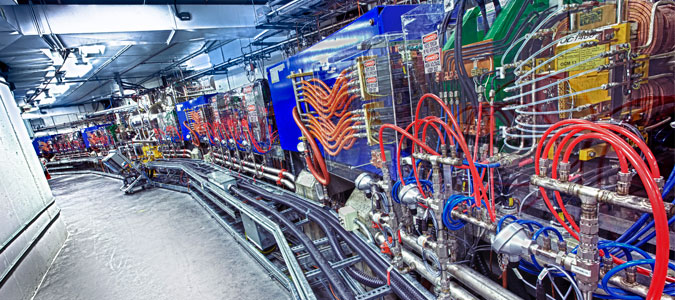Cryoplant failure shuts down CLS
A mechanical failure has forced a shutdown at the Canadian Light Source (CLS) and left staff working to repair the problem and reschedule synchrotron users who have lost time on the beamlines.
By Kris Foster
Canadian Light Source Photo provided by CLS
Mike McKibben, director of technical support at the CLS, said the problem developed Oct. 6 when a compressor motor failed in the facility's cryoplant, which cools helium to an incredibly low temperature—four kelvin. The liquid helium is used to cool the synchrotron's super conducting radio frequency cavity. "And if the cryoplant goes down, we don't run," said McKibben.
After the compressor motor was replaced and attempts were made to restart, oil was discovered in the cryoplant, frozen and creating blockages. McKibben said the entire operation was shut down, the helium carefully evacuated and stored, and the cryoplant warmed to allow for repairs. The first step was to run acetone through the cryoplant for five days to remove the oil.
Once the acetone was removed, McKibben said dry nitrogen was repeatedly circulated and removed from the cryoplant to extract the acetone. This was a two-week process. Before starting the three-day cool-down process, all the nitrogen is removed using a procedure called pump and purge. "We create a vacuum, then fill the cyroplant with helium and pump it back out again to ensure there's no nitrogen left in the system. Then we can re-cool the plant."
McKibben said there are some theories about how the oil got into the cryoplant and the CLS is working with the equipment vendor to consider the possibilities and correct any design flaws. "This problem is not common," he said, "but it's not totally unheard of."
The synchrotron was already scheduled for a regular maintenance shutdown starting Nov. 5, and that will proceed. Although it is a priority to reschedule users who unexpectedly lost beamline time in October, "we can't sacrifice normal maintenance to keep the machine running or we'll end up with unplanned outages that are even more expensive to repair."
He pointed out that a shut down at the CLS does not imply a slow down. In addition to the cryoplant repair, which could include the installation of an additional compressor to improve reliability, McKibben said shut downs "are a green light" to carry out maintenance on the 10-year-old synchrotron. Heavy work like jackhammering, for example, must be done when the system is down because it can disrupt the precise tolerances of the beamlines.
McKibben said beyond the cost of the cyroplant repairs, it is difficult to calculate the loss to the CLS caused by the unscheduled shut down. "It could be $1 billion from just one discovery coming out of a beamline. It's hard to put a value on the lost science."

